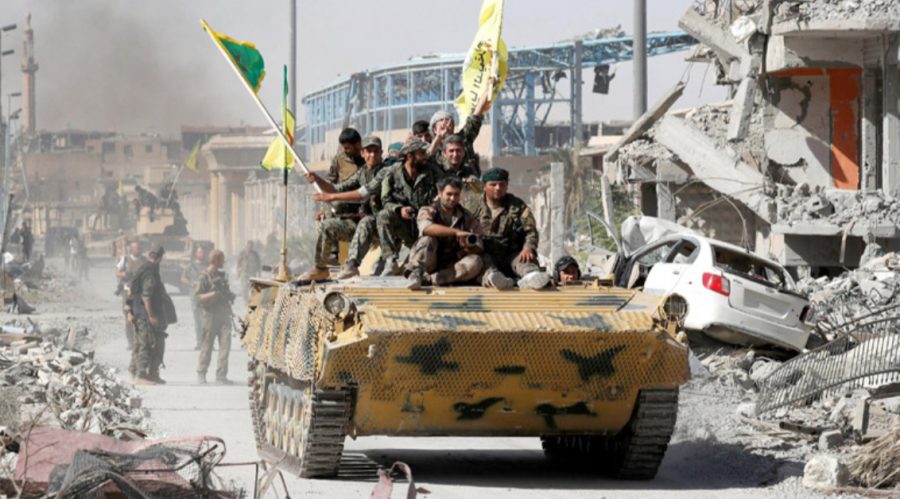Islamic State Leader Killed and Replaced after U.S. Withdrawal from Syria
Soldiers of the SDF celebrate after a successful fight against ISIS, which illustrates their anti-ISIS campaign.
November 4, 2019
U.S. Forces Kill ISIS Leader
About one week ago, a crucial milestone in the international fight against terrorism was met after U.S. forces killed ISIS leader Abu Bakr al-Baghdadi. According to President Trump, eight American choppers approached the terrorist leader’s location in Northwestern Syria. After exiting the helicopters, U.S. forces, including a military dog, chased him down a dead-end tunnel where he ultimately self-detonated a suicide vest. He, as well as three children who were with him, died. There were no fatalities among U.S. soldiers.
“Capturing or killing him has been the top national security priority of my administration.” -President Trump
According to the President, the effort was made possible through international cooperation. He explained that the U.S. was granted access to Russian airspace in order to approach the terrorist with aforementioned helicopters. Along with this, the Kurdish forces in Syria have been vital in locating and monitoring Baghdadi.
Despite neutralizing “the world’s No. 1 terrorist leader,” as phrased by Trump, there is still concern about future terrorist advancements in the region. According to Jennifer Cafarella, who works at the Institute for the Study of War, which is a Washington-based think-tank, “Killing leaders does not defeat terrorist organizations.” She cited the growth of Al Qaeda after Osama bin Laden’s death as an example of this. Additionally, the group has already named a new leader: Abu Ibrahim al-Hashemi al-Qurayshi. Although not a lot is known about him, many believe that name is a nom de guerre.
This Raid Follows Trump’s Order to Pull Out of Syria
About three weeks ago, Trump ordered that U.S. troops be pulled out of Syria, reasoning that the wars in Syria are endless. This decision was met with controversy from even his own party because by withdrawing from Syria, the U.S. would be effectively welcoming Turkey into the region. This was explicitly stated by the White House, which said that “Turkey will soon be moving forward with its long-planned operation into Northern Syria.” But anyone who understands the ramifications of this “long-planned operation” should understand its problematic nature.
First, it is important to understand that the region of Northeastern Syria that Turkey planned to and has already invaded is Rojava, which is an autonomous region that the Kurdish-led Syrian Democratic Forces (SDF) have created. This region was established by the Kurds due to a lacking of their own territory. By invading this territory, Turkey forced the Southward migration of possibly as many as 100,000 Kurds, according to the United Nations. Given that thousands of ISIS prisoners are held by Kurdish forces in Rojava, the southward fleeing of Kurds has led to the release of hundreds of ISIS prisoners.
Much of the controversy in Trump’s withdrawal decision is also well-founded in the fact that the Kurdish-led SDF, which Turkey recognizes as a terrorist group, has been historically among the U.S.’s most reliable allies in the fight against ISIS. This is affirmed in the fact that they have lost over 11,000 members to the fight against ISIS over the past couple of years.
Furthermore, Turkey’s advances have been recognized as illegal by international organizations such as the Arab League, the European Union, and the United Nations. Therefore, by withdrawing from the region, Trump indirectly enabled an invasion that the international community deplores. When this is compounded with the reality that Badghdadi was only successfully killed because there were enough U.S. troops in the region, it is apparent why his decision was met with bipartisan disapproval.
In light of this, Trump made a decision to redeploy troops into Northern Syria about two weeks ago. He stated that, “[U.S. forces] coming out of Syria will now redeploy and remain in the region to monitor the situation and prevent a repeat of 2014, when the neglected threat of ISIS raged across Syria and Iraq.” According to The New York Times, there may be as many as 900 of the 1,000 previously stationed troops there when his order is met.
So in the past month, troops have been withdrawn from and reployed into Syria, Kurds have fled their Northern Syrian homes, and the ISIS leader has been killed and replaced. As the aftermath of these events continues to play out, the international community is watching as new developments unfold.


